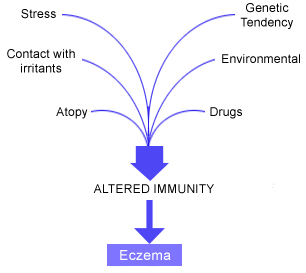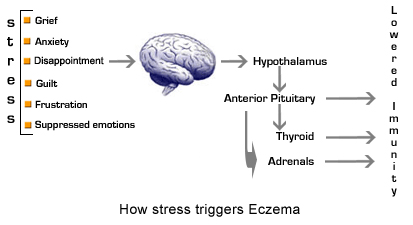|
| Vitiligo is a disease of skin pigments called melanin. Rather, it is a disease where there is a loss of skin pigment or color. Vitiligo is not a serious disease, medically speaking. It's social significance is more than medical importance, as it does not cause any major harm to the body. Cosmetically and personally, it can affect lives of the suffers especially in those society, where color of skin is given importance; specially among brown and dark skin people. |
| Causes |
In simple words, vitiligo is caused by one or two of the following processes:
1. Melanin cell destruction, leading to loss of colour on skin, leading to white patches of vitiligo.
2. Defective process of melanin formation, hence, no skin colour formation
There is no exact cause known for the above processes. There are some theories which are considered responsible for the above processes in vitiligo. The probable causes of vitiligo are explained elsewhere on this site. In brief, genetic and immunological factors in the background are considered responsible for vitiligo.
Due to destruction of the melanin (pigment) cells due to lesser known processes (largely what is called as an auto-immune disorder) the normal skin starts loosing pigments from various parts of the skin, in a varying speed and extent. Our clinical experience, suggests that there is a strong genetic factor in the background of most cases, especially those who have extensive vitiligo or those who have vitiligo affecting the finger-tips, toes, lips or the genitals. The indication of strong genetic factor is observed in the form of family history of one or more of the auto-immune diseases such as vitiligo, alopecia areata, diabetes, under active thyroid, , cancer, rheumatoid arthritis or allergies. |
|
|
In short, vitiligo is not as serious disease as it has been thought about. However, it calls for attention as it requires to be treated and managed.
The typical appearance of Vitiligo is a milky white de-pigmented spot or spots. It may vary from a single white spot to multiple spots. The shape too is a variable; round or irregular in shape. In some cases generalized de-pigmentation observed all over the body. It has a tendency to start as a single spot and gradually grow in size and number. It may present with a single or several spots on limbs or abdomen or back and then spreading to other parts of the body. In some of the vitiligo patches the hair may turn grey suggesting of loss of melanin pigment at the roots. |
|
 |
Some cases showing affection of the muco-cutaneous junctions such as finger-tips, corners of the mouth, genital, around eyes. The spread of the disorder is usually slow and progressive. Symmetrical appearance on both the sides of the body (say, on the legs, hands, etc.) is common. In rare cases one finds vitiligo spreading all over the body. It is a common concern among the patients if the disease would spread to entire body; which happens very rarely.
Bilateral symmetrical
Scattered (solitary)
Finger tips
Vitiligo with grey hair
Feet
Spread of vitiligo:
The spread of vitiligo is governed by various factors such as
1. Genetic activity
2. Hormonal factors
3. Continued Stress factors
4. Exposure to chemicals, etc.
Many patients may start with just a single spot and may not get more spots for many years or for throughout life time. Some patients may show rapid spread, as fast as from one spot to hundreds, in a few months time. It is not possible to predict the pace of spread. Also, some patients may show intermittent spread. It may be noted form experience that those who pace certain body areas affected such a finger tips, are at higher risk of having an aggressive spread; it is not a rule though. Some patients may present with grey hair, suggesting loss of pigment in the hair. |
| Associated Systemic Disorders: |
There are several systemic diseases (affecting the entire body system), which are at times associated with Vitiligo: 1. Under active thyroid 2. Diabetes 3. Alopecia Areata (patchy hair loss) 4.SLE (Systemic Lupus Erythematosus) 5. Pernicious Anemia 6. Addison's Disease 7. Collagen Diseases 8. Grave's Disease
It may be noted that the sufferers of Vitiligo need not be unduly scared of the above disease conditions, as they should not be regarded as the complications of Vitiligo in every case. The most common condition found along with vitiligo include Under active thyroid (hypothyroidism) and Alopecia areata (patchy hair loss).
Vitiligo is a disease of which the exact cause is not fully understood. However, there is increasing understanding about the processes involved in the development of Vitiligo. In most cases there are multiple causes responsible for vitiligo. However, there are theories suggesting
a. Autoimmune links: The cells fighting among themselves leading to destruction of the melanin, is one of the reasons. There are other immunological factors as well. One of the studies has suggested role of some neuropeptide (NYP) which may damage melanin. Such neuropeptide may be released in response to skin injury or emotional stress; again suggesting a combination of causative factors.
b. Hormonal connections: Affection of certain hormones such as Thyroid hormones or Melanocyte Stimulating hormone may be responsible for vitiligo. Also, simultaneous occurrence of vitiligo and other hormonal disorder suggest underlying genetic factor.
|
 |
c. Genetic tendencies
d. Neural theory
e. Autocytotoxic theory
As per this theory, there is self-destruction of melanocytes and hence the melanin. This could be a result of genetic, immunological, neural or stress factors.
There are factors, internal and external, which either predispose or trigger or maintain the process which leads to development of vitiligo. In most cases, more there may be a mix of causes.
The familial incidence of 20 to 30% is observed in the family members. If one or more of the parents have vitiligo, there are more chances of one developing the same. However, it is not a rule. At the same time, numerous cases of vitiligo do not have a relevant family history of Vitiligo. We have made an important observation through a study that most patients with vitiligo have one of the family members (father, mother, grand parents on either side, uncle, aunt or siblings) suffering from one or more of the following diseases:
a. Vitiligo
b. Hypothyroid or under active thyroid
c, Diabetes
d. Alopecia Areata (patchy hair loss)
d. Cancer
e. Other auto-immune diseases (such as psoriasis, rheumatoid arthritis, lichen planus, etc.)
A study at our center also shows that the patients who have either extensive vitiligo or those developing vitiligo spots on both sides of body (bilateral symmetrical) have a strong genetic element. In other words, it is difficult for any patient to have extensive vitiligo without genetic links. |
| Vitiligo and Hypothyroidism (Under active thyroid): |
Research suggests that Vitiligo and Hypothyroidism (Under active thyroid) often are predisposed by the same gene (NALP1 gene). All patients of Vitiligo are suggested to get Thyroid profile done every six months. Thyroid profile entails blood sample study for T3, T4 and TSH (Thyroid stimulating hormone) hormones at a small cost.
Other factors: The precipitating factors have been identified as due to pressure of tight clothes (such as on the waist) or certain occupational hazards such as wearing certain rubber hand gloves. Long term intake of certain drugs is found to produce this pigment disorder. In many cases, especially in children, we often have no clue why one develops vitiligo.
All said and done, there is definitely an abnormal process of melanocyte destruction and defective melanocyte formation, governed by known or unknown factors. |
| Homeopathic Treatment of Vitiligo: |
According to homeopathic philosophy leucoderma or vitiligo is not just a skin disease but it is the external manifestation of the internal derangement of the body. Thus, the treatment in homeopathy is aimed at curing this internal problem because only this would provide permanent relief from white patches. The patient is thus evaluated from different angles – physical, emotional, mental and familial. Also important is life situation prevailing when the problem started.
There are various remedies in homeopathy for leucoderma or vitiligo or white patches. A professional homeopath chooses the right one for a particular patient by carefully assessing his or her symptoms. This is very important because only the well-selected remedy would cure the patient. Also it is a chronic disease and may take considerable time to cure even with the best selected homeopathic remedy. The patients should keep this in mind and should be ready to cooperate with their homeopath.
Leucoderma or vitiligo is only curable in homeopathy while other treatments incuding sun exposure, ultraviolet radiation and external applications only provide temporary relief. Also allopathic treatment is associated with side effects like liver damage, skin allergy, nausea, cataract and other eye problems. The well-selected homeopathic remedies are without any side effects.
Many a times vitiligo or lecuderma is associated with stress, thyroid dysfunction, pernicious anemia, Addison's disease, alopacia areata (bald patches) and intestinal disorders. With homeopathic treatment the above conditions are also dealt with concurrently thus providing complete and permanent recovery.
Also I have observed that the patients recover faster if nonvegetarian food, milk, milk products and foods containing artificial colors and flavours are restricted. |
|